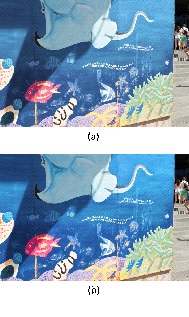BACKGROUND
The color gamut of a display is the set of colors that it can reproduce: screens with wider gamuts are capable of presenting more vivid, intense colors. Different display technologies have different gamuts, from the narrow gamut of TV sets to the wide gamut of cinema and the ultra-wide gamut of laser projectors. Gamut mapping is the process of adapting the colors of an image to the gamut of the display where it is shown.
Most existing image content has a standard (narrow) color gamut, as do regular screens, whereas new cameras and displays have a wide color gamut. This makes gamut mapping a key procedure in order to exploit the full potential of new display technology, by enhancing in new screens the appearance of legacy content, and by respecting on legacy screens the appearance of wide color gamut content.
Gamut mapping is an open challenge. There is a trade-off between speed and quality, and no method, be it automatic or manual, is exempt from issues. This is why major players in the field (e.g. Apple, Instagram, Technicolor, Dolby, BBC, NHK) currently devote R+D efforts to the gamut mapping problem, as recent publications attest.
Most of the methods for gamut mapping are global, i.e. they change pixel values regardless of their location in the image (e.g. the different gamut mapping methods used by Instagram, Dolby or the BBC, or the state-of-the-art academic work of [LMK]). Such methods are fast, but prone to issues such as producing artifacts and hue shifts in the processed images. Local gamut mapping methods, on the other hand, modify pixels by taking into account their local neighborhoods (e.g. the academic work [AF]); their results are better but not free from issues, plus they are computationally expensive.
The limitations of existing technologies stem from this quality vs. speed trade-off, and while it could be conservatively argued that current images “seem good enough as they are”, so there would not appear to be a clear demand for better pictures, the truth is that user tests clearly show that observers prefer results that have been accurately gamut-mapped.
TECHNOLOGY
Our method solves the gamut mapping problem, both for reduction and extension. It produces results that keep as much as possible the appearance of the original and does not introduce visual artifacts at any kind, see an example in Figure 1, a) Original. b) Our gamut extension method applied to image (a). The results have been validated by user tests and clearly outperform the state of the art. It is computationally very simple, so it can be used for real-time applications.
ADVANTAGES
The resulting transform is automatic (no need for user-selected parameters) and of extremely low computational complexity, making it a good candidate for real-time applications. It produces images and videos that look natural, without any halos, spurious colors or artifacts.
STATE OF DEVELOPMENT
Prototype software validated in laboratory environment running on a desktop PC. TRL 3.
INTELLECTUAL PROPERTY
A European patent with application number EP17382462.4 has been filed July 14, 2017
MARKET OPPORTUNITY
Our technology is of interest to companies in the media industries, all along the production chain: camera manufacturers (mobile, still photography, TV, cinema), producers of film, TV or videogames, content distributors (broadcast, internet streaming), and display manufacturers (mobile devices, TV sets, professional monitors). The extremely low complexity of our method allows for real-time software implementation, without any need to modify the hardware. It can also be used off-line, in professional settings, to automatize format conversion processes and produce content with optimal appearance.
COMMERCIAL OPPORTUNITY
Technology available for licensing
CONTACT
Marc Santandreu
Technology Transfer Unit
(+34) 93 542 28 96
[email protected]
KEYWORDS
Image processing, dynamic range, image appearance, visual perception, real-time applications
Ref: TEC-0165/P-0038
Fact sheet

